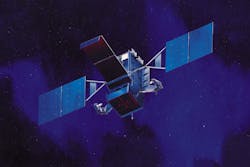Lockheed to provide Space Force with ground terminal for ballistic missile early missile warning sensors
PETERSON SPACE FORCE BASE, Colo. – Space sensors experts at Lockheed Martin Corp. will provide a ground terminal and other logistics support for a space-based ballistic missile early warning system under terms of a $13.4 million order announced in late May.
Officials of the U.S. Space Force Space Systems Command at Peterson Space Force Base, Colo., are asking the Lockheed Martin Space segment in Sunnyvale, Calif., to deliver a fourth operational SBIRS Survivable Endurable Evolution (S2E2) Mobile Ground Terminal.
The S2E2 missile warning program is replacing the Mobile Ground System (MGS), initially designed for support of the legacy Defense Support Program (DSP) satellite reconnaissance operations in the 1960s.
SBIRS has space and ground segments to provide infrared sensing from space to support the U.S. military and allies. SBIRS replaces or incorporates legacy DSP ground stations and satellites to improve timeliness, accuracy, and threat detection.
The U.S. Force is developing SBIRS in two system increments, the first to use the SBIRS fixed-site ground control segment with DSP satellites to sustain legacy DSP capability.
The second increment involves a space segment consisting of DSP satellites, hosted payloads in high-Earth orbit, and satellites in geosynchronous orbit.
Related: Lockheed Martin's SBIRS missile warning satellite now under U.S. Space Force control
The second increment also includes a mission control station fixed-site ground facility with software and hardware for consolidated data processing across all sensors; a mission control station backup ground facility; and the S2E2. Increment 2 includes four relay ground stations.
On this order Lockheed Martin will do the work at Peterson and Buckley Space Force Bases, Colo; Greeley Air National Guard Station, Colo.; and in Ogden, Utah, and should be finished by March 2024.
For more information contact Space Force Space Systems Command online at www.ssc.spaceforce.mil, or Lockheed Martin Space at www.lockheedmartin.com.

John Keller | Editor-in-Chief
John Keller is the Editor-in-Chief, Military & Aerospace Electronics Magazine--provides extensive coverage and analysis of enabling electronics and optoelectronic technologies in military, space and commercial aviation applications. John has been a member of the Military & Aerospace Electronics staff since 1989 and chief editor since 1995.

